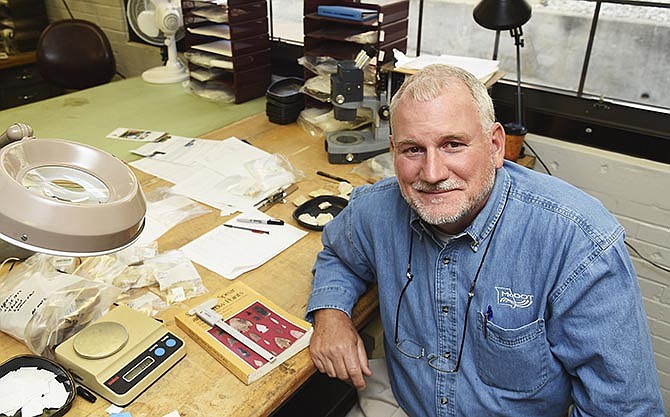To most people, a rock is a rock. To archaeologist Rusty Weisman, a rock is a story.
Working in the Missouri Department of Transportation's design division, Weisman often is out on right-of-way land or existing roadway shoulders looking for bits and pieces.
"Not finding anything is dreadfully boring," he said.
But finding "100 humpty-dumpties and most of the pieces are missing" can be just as frustrating, he said.
The latter happened in Franklin County, where a 4,000-year-old stone tool workshop likely was located.
One of the more interesting and long-lasting projects Weisman has been involved with at MoDOT is the Trail of Tears project in Southeast Missouri. Last month, the last of the interpretive signs along the wagon-trail route used by earlier travelers, including the 1838-39 Cherokee relocation from Georgia to Oklahoma, was installed at the Old Greenville Recreation Area in Wayne County.
Weisman was consumed enough by this project that he intends to continue researching the full 160 miles of the Binge Detachment route through Missouri on his own. He is interested in identifying the other old roads used by the other Cherokee detachments, which crossed the Mississippi River and travelled to Jackson and Farmington.
Another project Weisman has been involved with for many years is evidence of ancient earthquakes in Pemiscot County. An initial survey of the site was misplotted on a map, but Weisman rediscovered it during an I-55 project about a decade ago.
Leading paleoseismotologists from the United States and Japan have studied the site.
"It's a big deal," he said.
Not only does it show the effects of the 1811-12 earthquake, the remains of quakes in 1450 and 900 A.D. also are visible. The site is valuable for research to predict recurrence, he said.
Collaborating is an essential part of Weisman's work, he said. He works with property owners and contractors, as well as tribes, the Corps of Engineers, the National Park Service and the Forestry Service.
Weisman works on a team of 12 to comply with federal regulations in the National Historic Preservation Act.
MoDOT's goal is to identify and evaluate sites within the area of roadwork. For those sites deemed historically significant, they try to avoid damage by minimizing a project in that area or mitigating later to make up for the damage.
"We want to know what we're destroying when we do and avoid it when we can," Weisman said.
Growing up with a father and grandfather who were both professors at Case Western Reserve University in Cleveland, Ohio, Weisman said he expected early on he would also go into education.
Influenced by regular Saturday programs at the Cleveland Museum of Natural History while his father was at work, he discovered the Earth was a fascinating place. The cartoon "Mr. Peabody and Sherman," although silly, was also historical and inspired an adventurous spirit to know the past, Weisman said.
After his first archaeological field school in 1977, Weisman realized he had a knack for seeing things, to put together the puzzle pieces. Today, Weisman's MoDOT office features a photo from that dig as a reminder.
With undergraduate degrees in anthropology and geology, he worked five years at the Cleveland Museum of Natural History before going back for graduate school at State University of New York at Binghamton, where he specialized in ceramics.
He worked at consulting firms in New Orleans, Louisiana; Tuscaloosa, Alabama; and Fort Benning, Georgia, before coming to Missouri in 2000.
"All projects are fun and different," Weisman said. "The more you know about anything, the more interesting everything seems.
"The world is a fascinating place and lots has happened; there's still a lot to know."

